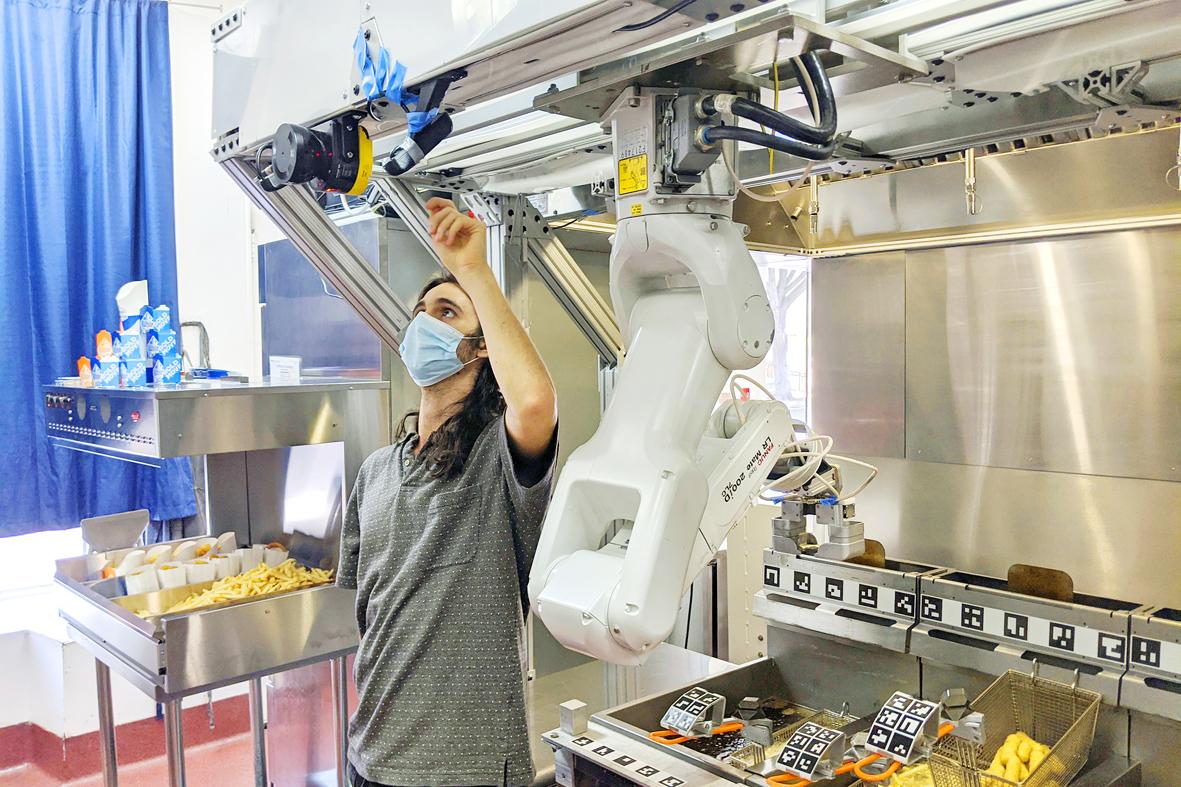Robots that can cook — from flipping burgers to baking bread — are in growing demand as virus-wary kitchens try to put some distance between workers and customers.
Starting this fall, the White Castle burger chain is to test a robot arm that can cook french fries and other foods. The robot, dubbed Flippy, is made by Pasadena, California-based Miso Robotics Inc.
White Castle and Miso have been discussing a partnership for about a year.

Photo: AP
Those talks accelerated when the COVID-19 pandemic struck, White Castle vice president Jamie Richardson said.
The robot can free up employees for other tasks such as disinfecting tables or handling the rising number of delivery orders, Richardson said.
A touch-free environment is also increasingly important to customers, he said.
“The world’s just reshaped in terms of thoughts around food safety,” Richardson said.
Flippy costs US$30,000, with a US$1,500 monthly service fee. By the middle of next year, Miso hopes to offer the robot free of charge, but raise the monthly fee.
Robot food service was a trend even before the pandemic, as hospitals, campus cafeterias and others tried to meet demand for fresh, customized options 24 hours a day while keeping labor costs in check. Robot chefs appeared at places such as Creator, a burger restaurant in San Francisco, and Dal.komm Coffee outlets in South Korea.
Some say that robots might now shift from being a novelty to a necessity.
The US Centers for Disease Control says the risk of contracting COVID-19 by handling or consuming food outside the home is low.
However, there have been numerous outbreaks among restaurant employees and patrons.
“I expect in the next two years you will see pretty significant robotic adoption in the food space because of COVID,” said Vipin Jain, the cofounder and chief executive officer of Blendid, a Silicon Valley start-up.
Blendid sells a robot kiosk that makes a variety of fresh smoothies. Customers can order from a smartphone app and tweak the recipe if they want more kale or less ginger, for example. Once or twice a day, a Blendid employee refills the ingredients.
Only a handful are now operating around San Francisco, but since the pandemic began, Blendid has started contract discussions with hospitals, corporations, shopping malls and groceries.
“What used to be forward-thinking — last year, pre-COVID — has become current thinking,” Jain said.
As salad bars shut down, Hayward, California-based Chowbotics started getting more inquiries about Sally, a robot about the size of a refrigerator that makes a variety of salads and bowls.
Sally lets customers choose from 22 prepared ingredients stored inside the machine. It can make about 65 bowls a day before kitchen workers need to refill the ingredients.
Prior to this year, Chowbotics had sold about 125 of its US$35,000 robots, primarily to hospitals and colleges, but since the novel coronavirus hit, sales have jumped more than 60 percent, chief executive officer Rick Wilmer said, with growing interest from grocery stores, senior living communities and even the US Department of Defense.
Wilkinson Baking Co, whose BreadBot mixes, forms and bakes loaves of bread, has also been getting more inquiries.
Randall Wilkinson, chief executive officer of the Walla Walla, Washington-based company, said the BreadBot serves shifting needs.
Grocery shoppers no longer want self-serve options such as olive bars, but they still want fresh and local food. Seeing how that food is made also gives them more confidence, he said.
Robot cooks have not always been successful. Spyce, a Boston restaurant with a robot-run kitchen, closed in November last year to retool its menu.
Zume Inc, a Silicon Valley start-up that made pizzas with robots, shut down its pizza business in January. It is now making masks and biodegradable takeout containers.
Max Elder, research director of the Food Futures Lab at the Palo Alto, California-based Institute for the Future, is skeptical about the future of food prep robots once the pandemic has eased.
“Food is so personal, and it needs to involve humans,” he said.
Elder is also concerned that focusing on automating food preparation during the pandemic will shift attention from other problems in the food system, such as outbreaks among meat industry workers or produce pickers.
“We can’t automate our way out of the pandemic, because the pandemic affects much more than what can be automated,” Elder said.
Automated food companies say that they are not trying to replace human workers.
At White Castle, Flippy would allow managers to redeploy workers to drive-thru lanes or help them cover a shift if an employee calls in sick, Richardson said.
Chowbotics’ Sally might actually create jobs, as it keeps selling food at times of day when it would not have been available before, Wilmer said.
However, robots can lower the demand for labor. At the University of Arkansas for Medical Sciences, workers used to spend six hours per day prepping grab-and-go salads in the 24-hour cafe, said Tonya Johnson, the school’s director of nutrition services.
Yet two years ago, the campus installed a Sally, which now makes an average of 40 salads per day. Sally allowed the school to eliminate a vacancy in its cooking staff, Johnson said.
The campus is buying another Sally for students to use when they return in August, which would save four hours per day of grab-and-go salad prep in the college deli, she said.
“I think the pandemic has made us realize how much we need more equipment like Sally,” Johnson said.

Hong Kong authorities ramped up sales of the local dollar as the greenback’s slide threatened the foreign-exchange peg. The Hong Kong Monetary Authority (HKMA) sold a record HK$60.5 billion (US$7.8 billion) of the city’s currency, according to an alert sent on its Bloomberg page yesterday in Asia, after it tested the upper end of its trading band. That added to the HK$56.1 billion of sales versus the greenback since Friday. The rapid intervention signals efforts from the city’s authorities to limit the local currency’s moves within its HK$7.75 to HK$7.85 per US dollar trading band. Heavy sales of the local dollar by

Taiwan Semiconductor Manufacturing Co’s (TSMC, 台積電) revenue jumped 48 percent last month, underscoring how electronics firms scrambled to acquire essential components before global tariffs took effect. The main chipmaker for Apple Inc and Nvidia Corp reported monthly sales of NT$349.6 billion (US$11.6 billion). That compares with the average analysts’ estimate for a 38 percent rise in second-quarter revenue. US President Donald Trump’s trade war is prompting economists to retool GDP forecasts worldwide, casting doubt over the outlook for everything from iPhone demand to computing and datacenter construction. However, TSMC — a barometer for global tech spending given its central role in the

The Financial Supervisory Commission (FSC) yesterday met with some of the nation’s largest insurance companies as a skyrocketing New Taiwan dollar piles pressure on their hundreds of billions of dollars in US bond investments. The commission has asked some life insurance firms, among the biggest Asian holders of US debt, to discuss how the rapidly strengthening NT dollar has impacted their operations, people familiar with the matter said. The meeting took place as the NT dollar jumped as much as 5 percent yesterday, its biggest intraday gain in more than three decades. The local currency surged as exporters rushed to

PRESSURE EXPECTED: The appreciation of the NT dollar reflected expectations that Washington would press Taiwan to boost its currency against the US dollar, dealers said Taiwan’s export-oriented semiconductor and auto part manufacturers are expecting their margins to be affected by large foreign exchange losses as the New Taiwan dollar continued to appreciate sharply against the US dollar yesterday. Among major semiconductor manufacturers, ASE Technology Holding Co (日月光), the world’s largest integrated circuit (IC) packaging and testing services provider, said that whenever the NT dollar rises NT$1 against the greenback, its gross margin is cut by about 1.5 percent. The NT dollar traded as strong as NT$29.59 per US dollar before trimming gains to close NT$0.919, or 2.96 percent, higher at NT$30.145 yesterday in Taipei trading